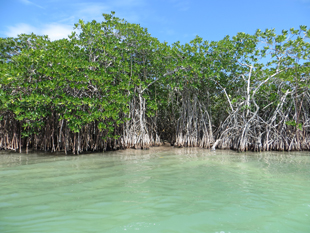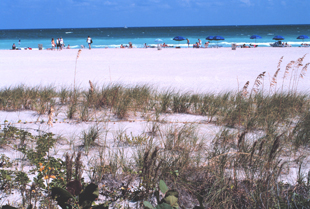Assigning Value to Nature at the Federal Level
A Q&A with ecosystem ecologist Ariana Sutton-Grier
Natural capital is a concept used to assign value to healthy, intact and productive ecosystems based on the benefits those ecosystems provide to humans. Such benefits are often called ecosystem services, and in some cases, they can be relatively easy to quantify. For example, resources such as fish, fruit and timber all have a defined value in an open market. Other benefits can be harder to pin down, such as the psychological benefits of having access to a clean beach or a lush forest trail to experience a connection with nature.
 Ecologists, economists, and resource management specialists have been working to help incorporate natural capital and ecosystem services concepts into federal policy. In a new perspective article published in the Proceedings of the National Academy of Sciences (PNAS), Ariana Sutton-Grier and her co-authors report that many U.S. federal agencies have made great strides to incorporate natural capital valuation into their resource management efforts over the past two decades.
Ecologists, economists, and resource management specialists have been working to help incorporate natural capital and ecosystem services concepts into federal policy. In a new perspective article published in the Proceedings of the National Academy of Sciences (PNAS), Ariana Sutton-Grier and her co-authors report that many U.S. federal agencies have made great strides to incorporate natural capital valuation into their resource management efforts over the past two decades.
Sutton-Grier, who is an assistant research scientist at the Earth System Science Interdisciplinary Center (ESSIC), a joint center of the University of Maryland and NASA's Goddard Space Flight Center, and an ecosystem science adviser for the National Ocean Service at the National Oceanic and Atmospheric Administration (NOAA), provided us with some insight on these developments.
It seems as though you and your co-authors describe a long-sought watershed moment in the incorporation of natural capital into federal decision-making. Is this a fair assessment?
That is certainly the hope! But of course only time will tell. Our article is one of several pieces in a special issue of PNAS dedicated to exploring these concepts, which demonstrates that a lot of progress has been made. So, this may be a watershed moment.
There has been an enormous amount of progress since I joined NOAA five years ago, and a lot of attention has been paid to the role that natural capital and ecosystem services can play in ensuring wellbeing for citizens. It’s important to look within agencies, but cross-agency efforts are also critical. Three consecutive presidential administrations—Clinton, Bush and Obama—have said, “We need to pay attention to the role of natural capital in our economy and how it helps support a successful society.” While this is a part of some agencies’ efforts, it is not yet mandated. There is support for agencies to keep working on this, but there is still progress to be made.
Early in the paper, you and your colleagues identify three notable success stories in the effort to establish environmental markets: sulfur dioxide trading, nutrient trading and wetlands mitigation banking. Why do you think these have been successful? Are there others that have seen similar success?
I think this question has a number of answers. Some people could debate the success of these markets, particularly in terms of ecological outcomes. Sulfur dioxide trading, which offers tradable credits to companies that demonstrate significant reductions in sulfur dioxide emissions, was absolutely successful in limiting the effects of acid rain. It was also one of the first such environmental market efforts, so enough time has passed for us to see the long-term impact of the policy in ways we haven’t seen for other markets yet.
 For example, nutrient trading provides tradable credits as incentives to reduce pollution from agricultural and industrial runoff. The market is getting underway and could be incredibly successful and cost-effective in efforts to clean up places like the Chesapeake Bay. But there hasn’t yet been enough time to measure long-term improvements in the Chesapeake Bay ecosystem. I’m hopeful that it will work, and the early indications are there, but it is a more complicated system than the sulfur dioxide trading market. You have to account for multiple state jurisdictions and different types and sources of pollutants, which makes it a more complicated market to establish.
For example, nutrient trading provides tradable credits as incentives to reduce pollution from agricultural and industrial runoff. The market is getting underway and could be incredibly successful and cost-effective in efforts to clean up places like the Chesapeake Bay. But there hasn’t yet been enough time to measure long-term improvements in the Chesapeake Bay ecosystem. I’m hopeful that it will work, and the early indications are there, but it is a more complicated system than the sulfur dioxide trading market. You have to account for multiple state jurisdictions and different types and sources of pollutants, which makes it a more complicated market to establish.
Wetlands banking allows companies to offset damage to wetlands by restoring or mitigating damage to wetlands elsewhere. Here is where the story gets a bit more complicated. A mitigated wetland might or might not be able to demonstrate equivalent function to natural wetlands. So setting an appropriate value for these credits can be problematic. Sometimes it is not one-to-one; instead, you have to trade several mitigated wetland credits for one natural credit. But in terms of setting up a market and being able to trade ecosystem services, it is definitely a success.
Much of my research has focused on a concept called “blue carbon,” which accounts for the fact that coastal and marine ecosystems can provide valuable carbon sinks. Coastal wetlands are a model for this. They are incredibly productive, sequestering carbon in vegetation that gets buried below ground. These wetlands occupy a very narrow band along the coast, but per unit area, they can bury up to 10 times more carbon than a tropical forest.
In a broader sense, carbon trading of all types has seen some success. Results have been varied, but because carbon dioxide mixes throughout the atmosphere at a global scale, any reduction in carbon emissions is good for the entire planet. This is why carbon markets have so much promise: the benefits can be realized globally, not just locally.
The paper points out that the next challenge is the valuation of non-tradable resources and other less-tangible ecosystem services. How well is this effort progressing, and what are the barriers inhibiting progress?
 There are some benefits that are theoretically quantifiable, but have been recognized only recently, so we are still learning how best to assign value to them. A good example is coastal storm protection offered by intact beaches, dunes, barrier islands and reefs. These coastal features won’t completely stop flooding, but they will slow and mitigate the intensity of storm surges. Even a narrow band along the coast can make a huge difference. Mangrove marshes in Florida are a good example, and are very helpful in protecting coastlines there. However, the amount of storm protection you get from a salt marsh varies seasonally. It is more effective in the summer when the plants are at their peak growth.
There are some benefits that are theoretically quantifiable, but have been recognized only recently, so we are still learning how best to assign value to them. A good example is coastal storm protection offered by intact beaches, dunes, barrier islands and reefs. These coastal features won’t completely stop flooding, but they will slow and mitigate the intensity of storm surges. Even a narrow band along the coast can make a huge difference. Mangrove marshes in Florida are a good example, and are very helpful in protecting coastlines there. However, the amount of storm protection you get from a salt marsh varies seasonally. It is more effective in the summer when the plants are at their peak growth.
Ecosystem services that provide aesthetic, cultural and spiritual benefits are very hard to quantify. Walking on the beach definitely provides psychological and physiological benefits. But how can we quantify this benefit, let alone assign a dollar value? We’re much more behind on understanding how much benefit people get from these experiences. Even when you look at time spent indoors, it’s clear that people feel more relaxed when looking out the window at a water feature or a verdant landscape. The precautionary principle is important here: we need to preserve nature even when we can’t yet give it a precise monetary value.
I largely agree with those who say that nature is invaluable, therefore we can’t possibly put a dollar figure on it. But if we don’t put a value on it, in policy and decision making contexts, the services and ecosystems in question are taken off the table as part of the discussion. And we really don’t want that. At NOAA, we make a clear distinction between valuation and monetization. If we can first assign value in other terms, then maybe if needed, in the future, we can put a dollar value on it. I recognize that monetization is an important step in the process because it represents value in a way everyone can understand. But we can do a lot toward valuation without ever getting to monetization. People can understand value in other terms, such as number of jobs supported or acres of crops pollinated. Dollars aren’t the only way to communicate the value of ecosystem services.
You and your co-authors discuss alternatives to measuring economic growth via gross domestic product (GDP), such as the Genuine Progress Indicator (GPI). Why are such measures important?
When we have, for example, a major oil spill, it causes a surge in GDP due to spending on the cleanup effort. The problem is there are huge environmental impacts that aren’t accounted for and that we can’t know the full effect of for decades or even centuries. GDP measures economic activity, but does not account for different kinds of activity. A rise in GDP does not necessarily mean that people are better off. We want a way to account for net benefits to both economies and ecosystems to truly reflect a better standard of living for people.
The paper discusses several ways in which natural capital has been incorporated into policy by presidential administrations. Why are these steps important?
The president can do a lot without issuing direct mandates or executive orders. By commissioning reports and convening panels, such as the President’s Council of Advisors on Science and Technology, the president can draw attention to critical issues and set priorities. Such measures can really influence federal agencies. If the administration is thinking about something seriously enough to convene a committee, it sends a clear signal that the issue is a priority. This helps let agencies choose to put resources into an area without worrying that they’re not in alignment with executive priorities. And that’s very powerful.
You and your co-authors say federal agencies need to consider three factors to incorporate natural capital into decision making more effectively: leadership, communication and training. Why are these factors important?
It truly takes all three of these—one or two is often not enough. You need the leadership support, as it will almost certainly take time and resources to see results. To get that buy-in from leadership, you need good communication. And to see positive results and build on successes, you have to have a well-trained staff on the ground working hard.
For example, in my own efforts to help get blue carbon going, we had two very effective partners in the nonprofit sector: Restore Americas Estuaries and Conservation International. Both have been instrumental in communicating the importance of this work to a broad audience, including bringing the message to NOAA leadership that NOAA has an important role to play. I have engaged in building capacity by training others, and I have seen firsthand the effectiveness of strategic communication, with NOAA leadership as well as with other scientists and other organizations. All three factors are important to move these ideas forward as smoothly as possible.
Is there anything else you would like to add?
 It’s important to note that the academic community and resource managers at federal agencies have to be strategic in these efforts. There has to be a clear need for action. I have seen some attempts to monetize an entire ecosystem, which have been interesting from an academic standpoint, but these efforts haven’t been too useful in terms of activating policy action because there hasn’t been a present need. It’s not useful to apply these concepts without a specific need or question in mind. Otherwise, you can expend a lot of effort with no end-user to take the information and do something with it. This is why I have focused on blue carbon and on coastal protection, especially in the wake of Superstorm Sandy, which renewed interest in using natural ecosystems to help reduce erosion and storm surge flooding.
It’s important to note that the academic community and resource managers at federal agencies have to be strategic in these efforts. There has to be a clear need for action. I have seen some attempts to monetize an entire ecosystem, which have been interesting from an academic standpoint, but these efforts haven’t been too useful in terms of activating policy action because there hasn’t been a present need. It’s not useful to apply these concepts without a specific need or question in mind. Otherwise, you can expend a lot of effort with no end-user to take the information and do something with it. This is why I have focused on blue carbon and on coastal protection, especially in the wake of Superstorm Sandy, which renewed interest in using natural ecosystems to help reduce erosion and storm surge flooding.
Looking at ecosystem services provides a very human-centered view of an ecosystem. There are all sorts of functions that an ecosystem can provide that don’t directly benefit or even affect humans. So by definition, ecosystem services are driven by human needs as identified by society. How do we identify these needs in the first place? That’s an ongoing challenge and we continue to identify new services—particularly health-related benefits of ecosystems. This is an important part of the process. There is still much work to be done on ecosystem services, but we’re getting there.
###
The perspective article “Nature as capital: Advancing and incorporating ecosystem services in United States federal policies and programs,” Mark Schaefer, Erica Goldman, Ann Bartuska, Ariana Sutton-Grier and Jane Lubchenco, was published on June 16, 2015, in the Proceedings of the National Academy of Sciences.
Media Relations Contact: Matthew Wright, 301-405-9267, mewright@umd.edu
University of Maryland
College of Computer, Mathematical, and Natural Sciences
2300 Symons Hall
College Park, MD 20742
www.cmns.umd.edu
@UMDscience
About the College of Computer, Mathematical, and Natural Sciences
The College of Computer, Mathematical, and Natural Sciences at the University of Maryland educates more than 7,000 future scientific leaders in its undergraduate and graduate programs each year. The college's 10 departments and more than a dozen interdisciplinary research centers foster scientific discovery with annual sponsored research funding exceeding $150 million.


